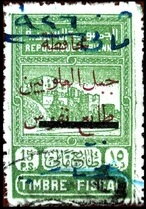Stamp: Aleppo Citadel (Alaouites 1948)
Aleppo Citadel (Alaouites 1948)
01 January (Alaouites ) within release Fiscal goes into circulation Stamp Aleppo Citadel face value 15 Syrian piastre
| Stamp Aleppo Citadel in catalogues | |
|---|---|
| Colnect codes: | Col: SY-ALA F1948-12 |
Stamp is square format.
Syria fiscal stamp with a three-line "Mohafiza Jebel al-Alawiyin Census Tax" (Government of Jebel Alaouites Census Tax) Arabic overprint in red, with the final line obliterated by a black bar Year of issue is approximate Revenue Reverend cat. no: X132Also in the issue Fiscal:
- Stamp - Aleppo Citadel face value 15;
- Stamp - Harvester face value 10;
|
Data entry completed
53%
|
|
|---|---|
| Stamp Aleppo Citadel in digits | |
| Country: | Alaouites |
| Date: | 1948-01-01 |
| Perforation: | 11 |
| Emission: | Revenue |
| Format: | Stamp |
| Face Value: | 15 Syrian piastre |
Stamp Aleppo Citadel it reflects the thematic directions:
Architecture (Latin architectura, from the Greek ἀρχιτέκτων arkhitekton "architect", from ἀρχι- "chief" and τέκτων "builder") is both the process and the product of planning, designing, and constructing buildings and other physical structures. Architectural works, in the material form of buildings, are often perceived as cultural symbols and as works of art. Historical civilizations are often identified with their surviving architectural achievements.
A building or edifice is a structure with a roof and walls standing more or less permanently in one place, such as a house or factory. Buildings come in a variety of sizes, shapes and functions, and have been adapted throughout history for a wide number of factors, from building materials available, to weather conditions, to land prices, ground conditions, specific uses and aesthetic reasons. Buildings serve several needs of society – primarily as shelter from weather, security, living space, privacy, to store belongings, and to comfortably live and work. A building as a shelter represents a physical division of the human habitat (a place of comfort and safety) and the outside (a place that at times may be harsh and harmful).
A census is the procedure of systematically acquiring, recording and calculating population information about the members of a given population. This term is used mostly in connection with national population and housing censuses; other common censuses include censuses of agriculture, traditional culture, business, supplies, and traffic censuses. The United Nations (UN) defines the essential features of population and housing censuses as "individual enumeration, universality within a defined territory, simultaneity and defined periodicity", and recommends that population censuses be taken at least every ten years. UN recommendations also cover census topics to be collected, official definitions, classifications and other useful information to co-ordinate international practices
A monument is a type of structure that was explicitly created to commemorate a person or event, or which has become relevant to a social group as a part of their remembrance of historic times or cultural heritage, due to its artistic, historical, political, technical or architectural importance. Examples of monuments include statues, (war) memorials, historical buildings, archaeological sites, and cultural assets. If there is a public interest in its preservation, a monument can for example be listed as a UNESCO World Heritage Site. The Palgrave Encyclopedia of Cultural Heritage and Conflict gives the next definition of monument:




